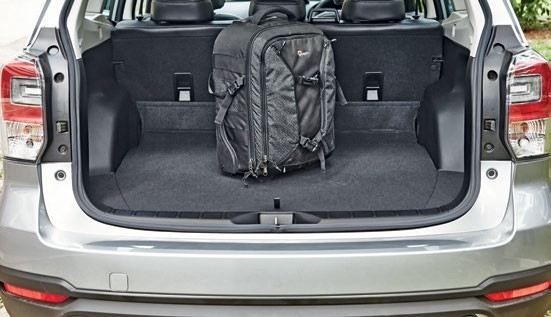These 2-litre all-wheel-drive SUVs both aim to score well with buyers who lead active and rugged lifestyles.


These 2-litre all-wheel-drive SUVs both aim to score well with buyers who lead active and rugged lifestyles.

SUBARU FORESTER 2.0I-L versus TOYOTA RAV4 PREMIUM 2.0
IF you’re the sort of person whose weekends are filled with football games (on a real field, not on a PlayStation) and unbeaten trails, then you may be considering a sports utility vehicle (SUV) to suit your active lifestyle.
There are plenty of choices available if you’re looking for such a car, and the Subaru Forester and Toyota RAV4 featured here would certainly satisfy your requirements.
These two Japanese models offer loads of practicality together with a decent dose of ruggedness. Both have also been recently facelifted to keep them fresh and help them stand out in a very competitive segment.
Following a nip-and-tuck, the RAV4 now has a sharper-looking front end. It has a more streamlined grille and headlamp design, as well as a reshaped bumper to give it a more distinctive-looking face.
The headlamps are now LED items that incorporate Daytime Running Lights (DRLs). The taillights, too, have been slightly tweaked, but otherwise the car’s overall silhouette remains unchanged.

The changes to the facelifted Forester are more minor in comparison. The only cosmetic differences are really just the slightly different grille design and the new LED headlamps, which now incorporate automatic height levelling and the ability to turn their beams to match the steering’s direction.
It’s very much the opposite story when you step inside both cars.
The RAV4’s interior has remained virtually unchanged, with the updated instrument cluster and the infotainment system, which offers better integration with your smartphone’s functions, being the only noticeable differences.
The rest of the cabin remains typically Toyota, having generally decent build quality, but with a few cheap plastics and materials here and there, most notably around the centre console and the glovebox cover.
Meanwhile, the Forester feels more upmarket than before, thanks to Subaru’s greater efforts to inject a bit more class and quality into the cabin.
Glossy piano-black finishes adorn the areas across the dashboard, around the centre console and gear selector, as well as on the door trims. It’s a stark contrast to the pre-facelift Forester, which has plenty of matte plastic.

Forester’s flat-4 is smoother and quieter than the RAV4’s inline-4.

"THE FORESTER HAS A NICER CABIN, BUT THE RAV4 IS ROOMIER AND MORE PRACTICAL."

"THE FORESTER HAS MORE TORQUE, BUT THE RAV4 IS QUICKER FROM ZERO TO 100KM/H."

But when it comes to accommodating all the knickknacks that an active lifestyle entails, the RAV4 edges out the Forester.
With 550 litres of boot space (seats up) as compared to 505 litres for the Forester, you can stow enough footballs and soccer kits in the RAV4 to supply an entire team.
With the rear seats folded down, the respective figures are 1575 litres and 1750 litres. Both boots are large enough to easily accommodate a big bicycle.
Both these SUVs are level, though, in terms of output, with the RAV4 and Forester both powered by naturally aspirated 2-litre petrol engines that each produce 150bhp.
The Forester has slightly more torque, 198Nm versus the RAV4’s 196Nm, but the RAV4 is surprisingly quicker to 100km/h from a standstill, taking just 10.7 seconds as compared to the Forester’s 11.8 seconds.
In truth, though, neither vehicle feels particularly stirring, perhaps due to the fact that they both have fairly relaxed CVTs that are linear in nature and emphasise smoothness over brisk acceleration.
Similarly, both the RAV4 and Forester are unlikely to excite keen drivers with their safe but staid driving characteristics.
Both cars turn in keenly with a neutral poise, but there is a lack of steering feel. Their ride qualities are comfortable, though.
The Forester and RAV4 are equipped with all-wheel-drive systems, which should prove useful should you find yourself taking a wrong turn and ending up on a muddy football pitch. But in most urban situations in Singapore, one is unlikely to put such systems to much use.
Where these two differ significantly is in pricing. At press time, the Forester retails for $117,800 and the RAV4 sells for $156,888.
The Subaru can attribute its lower price tag to its $15.7k open market value (OMV), while the RAV4’s OMV stands at $33.9k.
Despite the Forester’s lower OMV, you get a fairly long list of standard features, such as cornering headlamps, a powered glass sunroof and a pair of useful roof rails.
The RAV4 does without the above features despite its heftier price tag, but comes with an electric power tailgate, which is absent on the Subaru.
This match-up between these two Japanese crossover SUVs is a close one. The Forester scores with its excellent value and markedly better interior quality, while the RAV4 strikes back with its greater interior space and practicality.
But the $40,000 premium commanded by the RAV4 is hard to ignore, so the Subaru Forester escapes with a narrow victory.

























